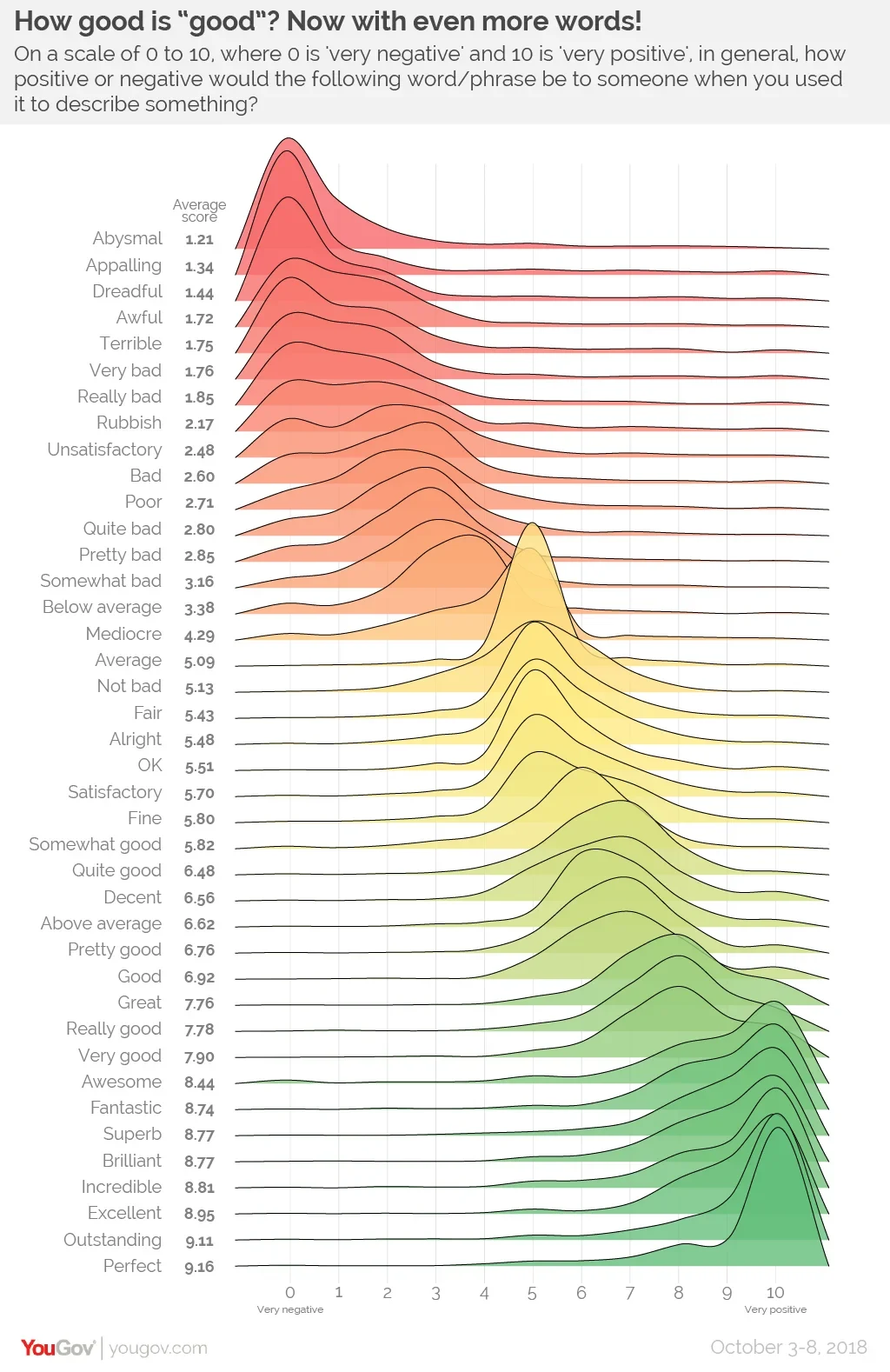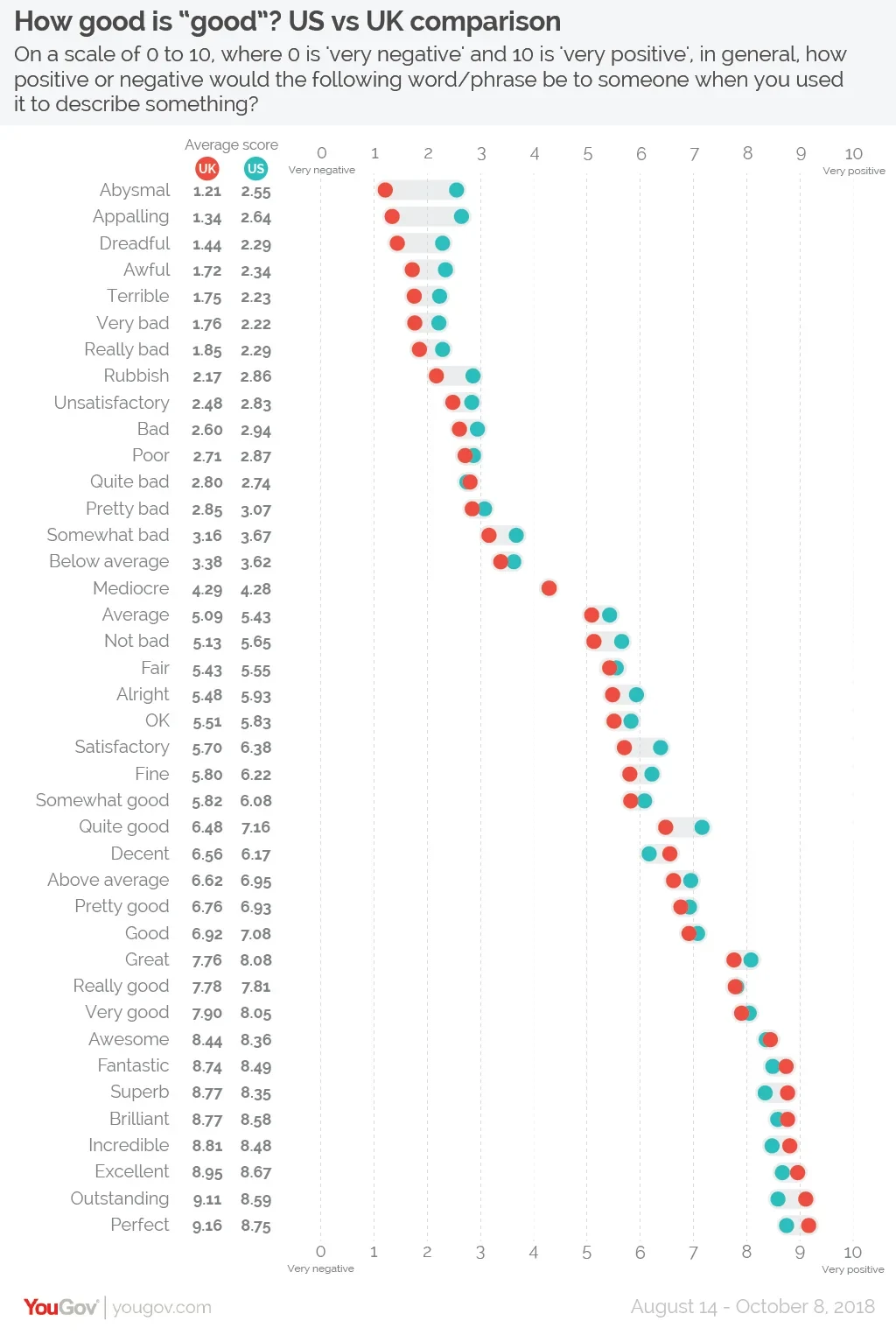A new YouGov study looks at exactly how positive and negative various descriptions are seen as being
This article was amended on 11 October to include an expanded set of words and the comparison results of the same survey in the United States
Go shopping online and just about everything you look at will have a star rating based on reviews by previous customers. Alas, it is less easy to quantify things in such a way in day-to-day life – if for instance your friend was reviewing a product to you, where would their description fall on the star scale?
(Such knowledge might also be useful to, say, an opinion pollster that was looking to discover the best pairings of words for sentiment scales…)
Well Britons need be left in the dark no longer! A new YouGov study reveals exactly how positively and negatively the population perceives various descriptions to be.
YouGov showed respondents a selection of adjectives from a list of 24 and asked them to score each on a scale from 0-10, with 0 being “very negative” and 10 being “very positive”.

“Abysmal” is the worst, and “perfect” is the best
Of the 40 words we tested, “abysmal” was seen as the most negative, with an average score of 1.21. Slightly less bad comes the closely clustered “awful” (1.72), “terrible” (1.75) and “very bad” (1.76).
At the other end of the scale, “perfect” is the most positively regarded word with an average score of 9.16. Only one other word managed to break the 9.00 barrier, which was “outstanding” on 9.11 (although “excellent” was not far behind at 8.95).
“Average” provides the best middle point
Bang in the middle is “average”, with a pleasingly average score of 5.09. Also very close to the centre point is “not bad”, with an average score of 5.13. However it is worth noting that “average” is a much better word to use as a mid-point on a sentiment scale, as 66% of respondents scored the word a 5 on the scale, compared to only 33% who did for “not bad”.
In fact, more people scored “OK” a 5 on the scale (46%) than did so for “not bad”, but overall sentiment for this term tended more towards the positive (with an average score of 5.51).
“Good” isn’t as good at being good as “bad” is at being bad
As it turns out, “good” and “bad” are not exactly mirrors of one another on the scale. Bad has an average score of 2.60, meaning its mirror equivalent on the scale ought to score 7.40. “Good”, by contrast, scores a 6.92.
This situation remains the case for the other examples where “good” and “bad” are used: “pretty good”, “really good” and “very good” are seen less positively than they should be to truly mirror “pretty bad”, “really bad” and “very bad”.
A much better pairing, by contrast, comes in the form of “below average” and “above average”, which at 3.38 and 6.62 respectively are exact mirrors of one another.
Two countries separated by a common language
Comparing the results with those of an identical study published by YouGov US reveals that the stereotype of Britons being less enthusiastic generally holds up – except for the very most positive words.
For the 31 words that scored below 8/10 in both countries, Britons gave 28 of them a lower average score than Americans did. However, for the nine highest ranked words Britons rated eight of them more positively.

The biggest differences come at the most negative end of the spectrum.
The single largest variation was over the word “abysmal”, which Britons rated 1.21 on average compared to 2.55 for Americans – a difference of 1.34 points.
A similar difference exists for “appalling”, which Americans rate 1.30 points more positively with an average rating of 2.64 compared to that of 1.34 among Britons.
The two dialects are closest to being united on “mediocre” with just a one-hundredth of a point separating Britons (4.29) and Americans (4.28).
Photo: Getty
See the full results here and here. US results can be found here.








